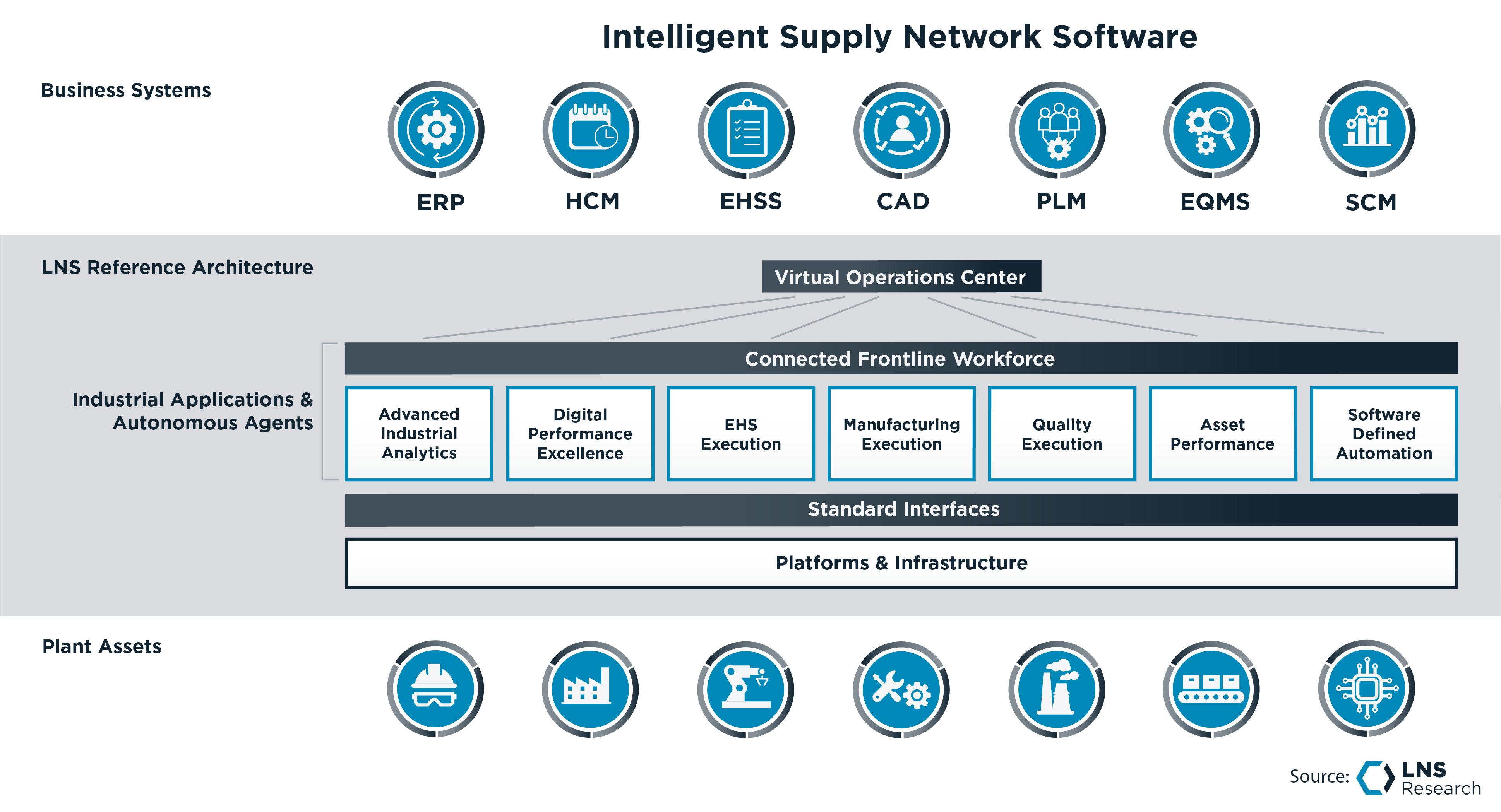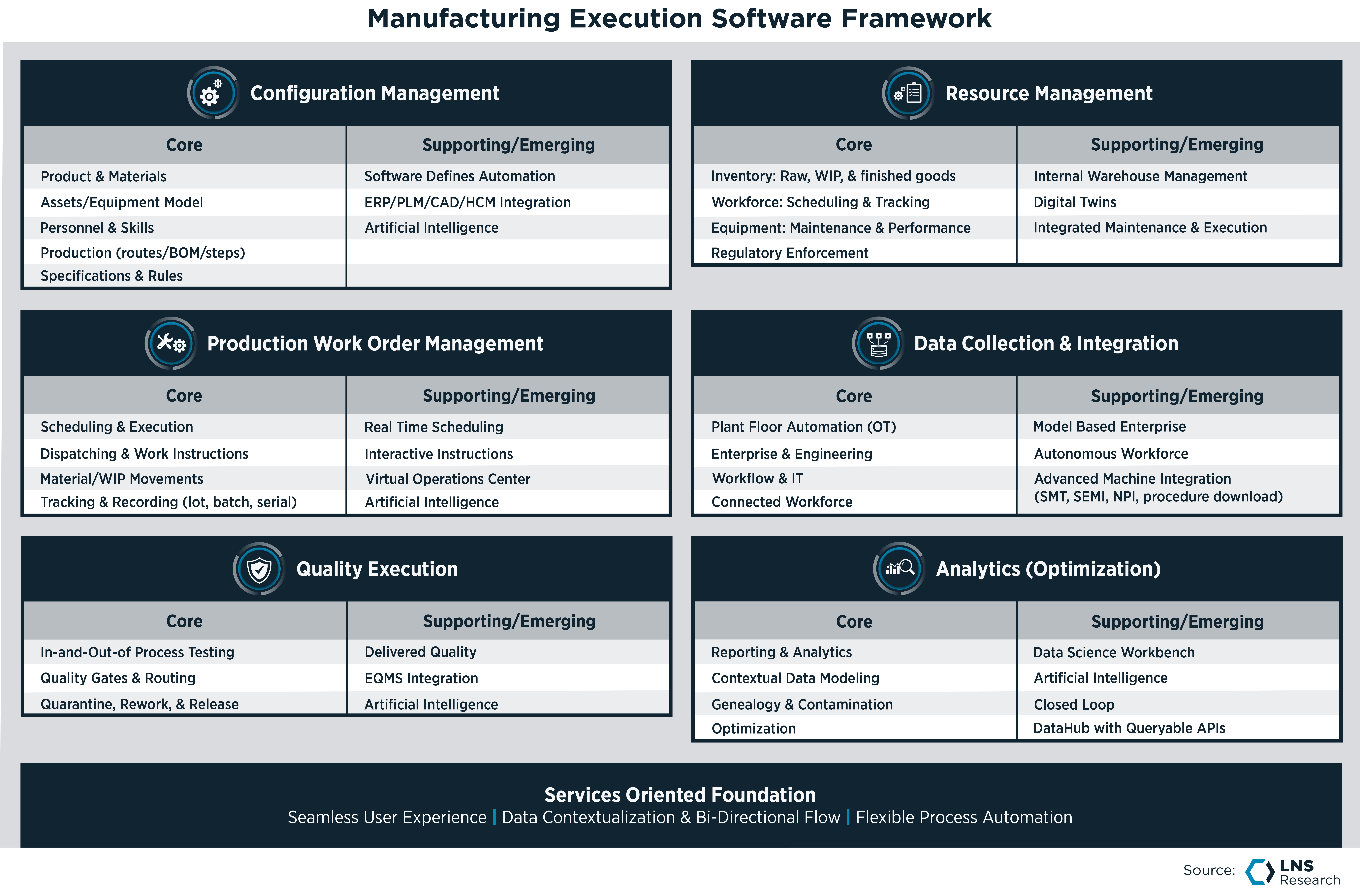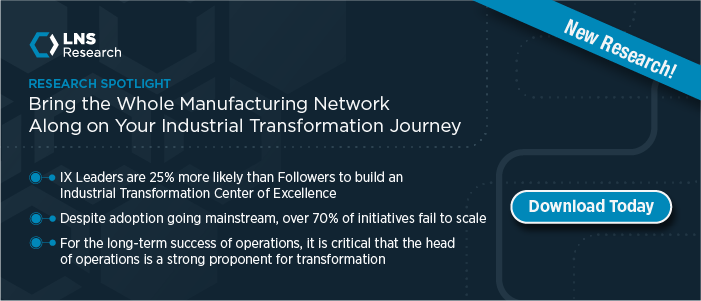“Why are we not classified as a Connected Frontline Workforce platform?” one vendor asks. “We do MES too!” another boasts. The louder the claims get, the harder it becomes for operations leaders to decide where to place the next dollar. Fear of missing out can freeze technology roadmaps; clarity gets them moving again. By the end of this article, you will know exactly where a Manufacturing Execution System (MES) excels, where a Connected Frontline Workforce (CFW) solution shines, and how the two can coexist without locking your plant into regret.
Where MES and CFW Fit in the Intelligent Supply Network
The industrial software stack is no longer a neat pyramid. Modern manufacturers build an “intelligent supply network,” a web of interoperable applications that serve equipment, materials, and people. MES still controls and tracks production at the work‑order and asset level, while CFW rides across layers as the unified user experience for frontline employees.

Figure 1: The LNS Research Intelligent Supply Network Framework
What An MES Really Is
MES emerged in the early 1990s, formalized by the original MESA‑11 model, as the system of record for what, where, when, and how a product is built. Its core strengths remain genealogy, routing, compliance records, and tight integration with automation and enterprise resource planning. In highly regulated or configuration-intensive industries — think pharmaceuticals, aerospace, and semiconductors- those capabilities are non-negotiable.

Figure 2: Manufacturing Execution Software Framework
While MES often describes a wider system that includes many capabilities, LNS Research often breaks the functions down to Manufacturing Execution (ME) and Quality Execution (QE). Manufacturing Execution is focused on the steps that convert raw materials to finished goods, whereas Quality Execution is focused on the steps necessary to deliver high-quality products. In addition, MES is often focused on being the system that enables Operational Excellence at the manufacturing level. The software applications may be delivered as individual components or together.
What a CFW System Really Is
CFW solutions start with the worker, not the machine. They deliver persona-based apps that put standard work, training, collaboration, and AI insights in one intuitive interface, no matter the device. Low-code configurability lets plants iterate instructions and checklists in hours instead of weeks, a must for operations dominated by manual or repetitive tasks.
%20Applications-1.png?width=9543&height=5907&name=2025%20Connected%20Frontline%20Workforce%20(CFW)%20Applications-1.png)
Figure 3: Connected Frontline Workforce Applications
The Overlap - and Why It Matters
MES and CFW intersect in multiple areas: contextual work instructions, lightweight execution, skill verification, user experience, and team collaboration. Some practical examples include operations in quality and execution. Vendors naturally expand into adjacent white space, so MES products borrow CFW-style task lists, while CFW vendors add simple data collection and quality checks. That overlap is good news, because it lets leading plants use CFW as the front end for a modular, API‑first MES. The result: one consistent interface for operators, no duplicate data models, and clearer ownership of heavy governance versus flexible content.
 Figure 4: Overlap Between CFW and MES
Figure 4: Overlap Between CFW and MES
When to Lean CFW, When to Lean MES
Choose CFW first when the operation is manual or highly repetitive, work‑in‑process tracking is simple, and the business value lies in standardizing work, boosting engagement, and capturing institutional knowledge. An example is the implementation of Operational Excellence for shift handovers, where standardized procedures and precision are essential.
Choose MES first when regulatory compliance, detailed genealogy, or complex, multi-step routings dominate. Here, the depth of logic and audit trails outweighs interface elegance. Hybrid models are common. Plants often run MES for core material flow and layer CFW on top for training, collaboration, and digital boards — extracting value from both without over‑buying either.
A Five-Step Selection Process
-
-
-
Clarify objectives. Tie every requirement back to business outcomes—cycle time, first‑pass yield, workforce agility.
-
Engage stakeholders. Operations, quality, IT, and HR all own slices of the outcome.
-
Map personas and use cases. Distil operator, team lead, and engineer journeys before drafting a spec.
-
Document requirements. Separate must-haves from nice-to-haves so scope creep does not decide the budget.
-
Match capabilities to gaps. Evaluate vendors on how their core strengths close priority gaps; avoid scoring every feature equally.
Recommendations & Call to Action
-
-
-
Start with business objectives, not technology labels.
-
Simplify before digitizing; lean processes amplify software value.
-
Map use cases to strengths—MES for material‑flow complexity and compliance, CFW for workforce engagement and guided manual work.
-
Run deliberate pilots, letting CFW provide the user experience for a headless or API‑centric MES.
-
Select partners with cross-domain expertise so integration stays predictable, and upgrades stay simple.
Next step: Benchmark your roadmap against peers—schedule a session with LNS Research to validate priorities.
Further Reading from LNS Research
